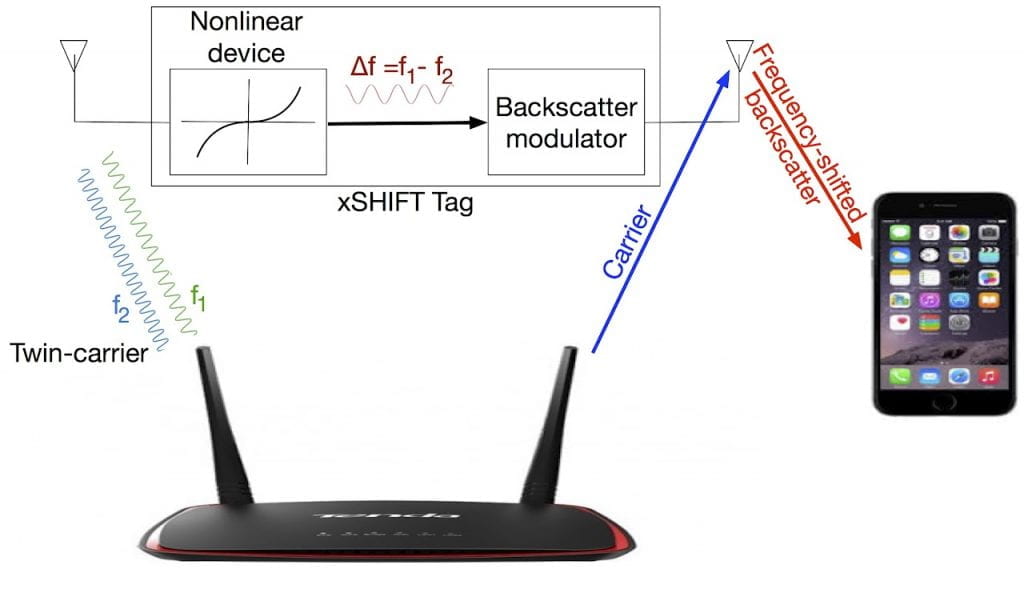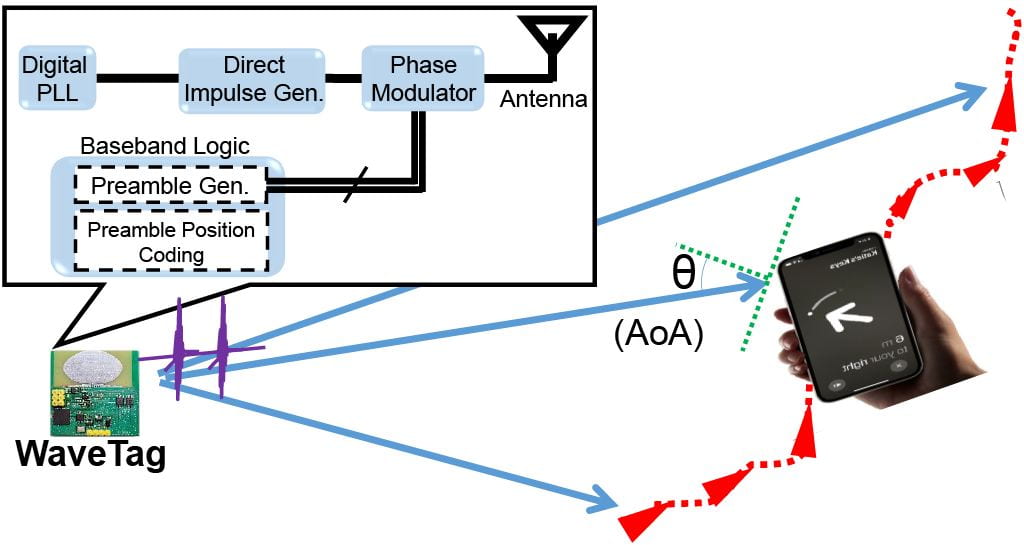This line of research explores the design of innovative ultra-low power wireless tags that can directly communicate with existing Wi-Fi infrastructure and user devices (smartphones, tablets, etc.). The deployment of these tags enables low cost, pervasive solutions for environmental sensing (e.g., temperature) and monitoring, real-time tracking, beaconing, etc. in supply chains, smart homes, healthcare, and many other practical applications that benefit from a sustainable, low-overhead Internet of Things (IoT).
Battery-free commodity tags: In this project, we design and implement ultra-low power and battery-free RF tags that can directly send ([1]*) and receive ([2]**) data from existing commodity radios such as Wi-Fi and Bluetooth Low Energy (BLE). Battery-free RFID tags have been in the market for decades. But their reliance on dedicated RFID readers that operate at a totally different frequency band (900MHz) deployed in the environment has severely limited their use cases for many applications.
Thereby, we enable tags based on the same technology (passive and backscatter radios) whose signals can be directly decoded by Wi-Fi/BLE receivers. This requires several technical innovations for addressing practical challenges such as (1) how to decode the weak backscatter signal in the presence of the strong Wi-Fi signals over the air? (2) how to enable frequency-shifting at microwatt regimes? (3) how to modulate/demodulate sophisticated signals such as OFDM or GFSK used in standard compliant BLE/Wi-Fi packets? (4) How to extend the communication range to practical distances? Etc.

High-precision pervasive tracking: Tracking tags such Apple AirTag or Samsung SmartTag which allow users to find items with their smartphones have recently become very popular products. They employ Ultra Wide Band (UWB) technology for precision-finding. However, they would only last for a few months in applications which requires continuous tracking. Also, thy price of the tag (~$30) limits their scalable deployment.
The key objective of this project is to extend the battery life and reduce the cost of UWB tags dramatically without compromising its ranging precision. Our innovative implementation ([3]***) is a carrier-less UWB transmitter design. The tag wakes up quickly, sends a short (128 us) standard UWB preamble without using any RF oscillator or PLL, and then goes to deep sleep mode. This makes the cost as well as the energy consumed for sending one preamble one order of magnitude lower than state-of-the-art UWB tags. Also, we have verified less than 1m localization error at distances up to 30 meters, based on angle of arrival (AoA) detection, which makes the deployment of UWB anchors much less expensive.

Distributed smart arrays: This project explores how ultra-low power tags can. So far, most of the focus in ultra-low power tags has been on how single tags operate standalone. How about making these tags smart enough to coordinate and deliver better signals, save more power, etc.?
References:
[1] Mohammad Rostami, Karthik Sundaresan, Eugene Chai, Sampath Rangarajan, and Deepak Ganesan. 2020. Redefining passive in backscattering with commodity devices. In Proceedings of the 26th Annual International Conference on Mobile Computing and Networking (MobiCom ’20). Association for Computing Machinery, New York, NY, USA, Article 3, 1–13. https://doi.org/10.1145/3372224.3380880
[2] Mohammad Rostami, Xingda Chen, Yuda Feng, Karthikeyan Sundaresan, and Deepak Ganesan. 2021. MIXIQ: re-thinking ultra-low power receiver design for next-generation on-body applications. In Proceedings of the 27th Annual International Conference on Mobile Computing and Networking (MobiCom ’21). Association for Computing Machinery, New York, NY, USA, 364–377. https://doi.org/10.1145/3447993.3483270
[3] Mohammad Rostami and Karthikeyan Sundaresan. 2022. Enabling high accuracy pervasive tracking with ultra low power UWB tags. In Proceedings of the 28th Annual International Conference on Mobile Computing And Networking (MobiCom ’22). Association for Computing Machinery, New York, NY, USA, 459–472. https://doi.org/10.1145/3495243.3560542
